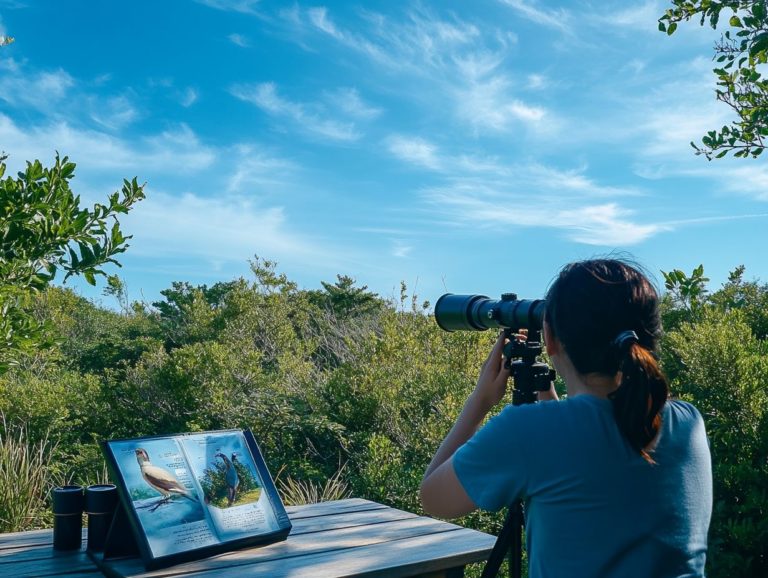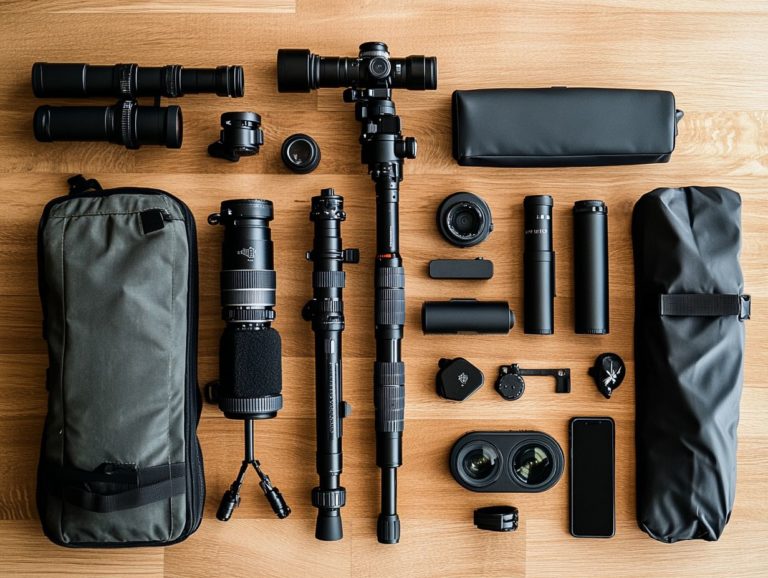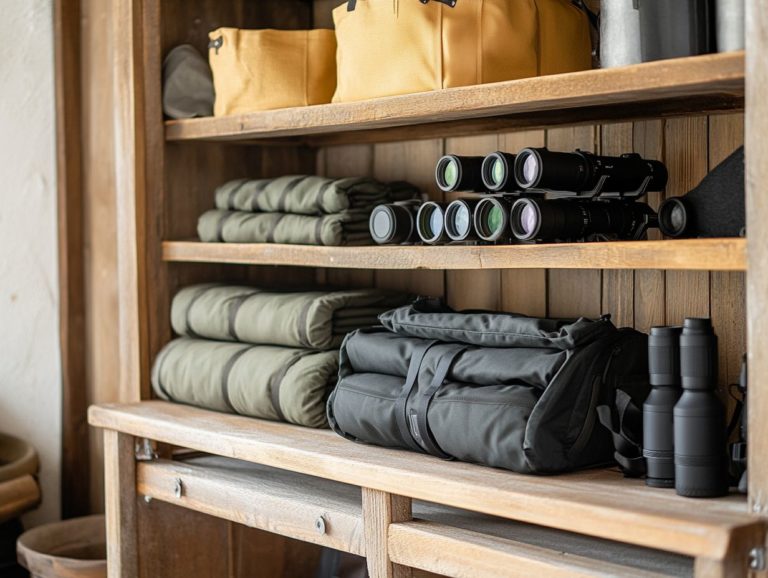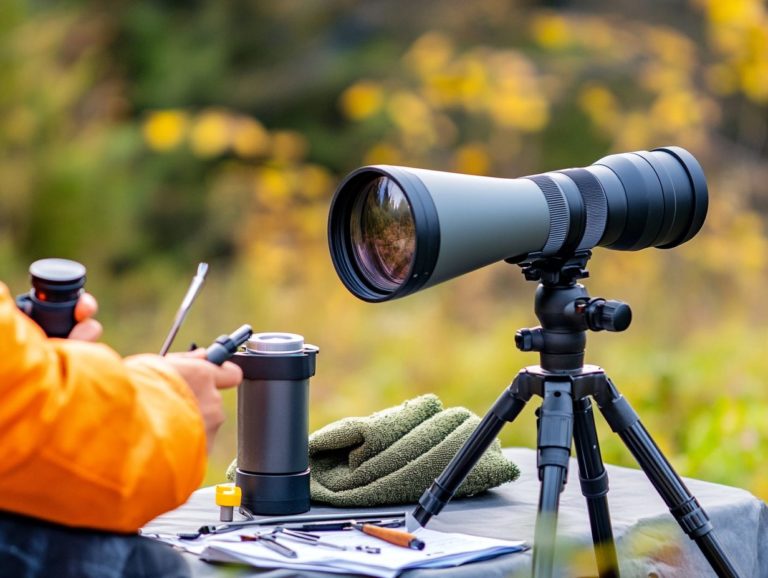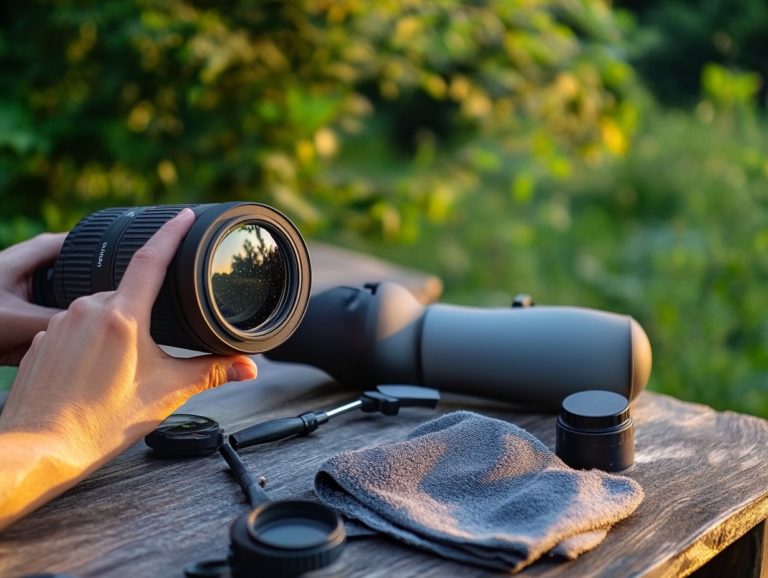Choosing a Spotting Scope for High Altitude Birding
Birdwatching at high altitudes brings a unique thrill. Having the right equipment, especially a high-quality spotting scope, is essential for spotting elusive avian species.
This guide explores the features of spotting scopes, focusing on aspects like magnification power and the size of the lens that helps you see clearly, along with important factors such as eye relief and lens coating.
You ll discover the benefits of different types of scopes, from straight to angled designs. You ll also receive expert advice on selecting the perfect model, whether it s compact spotters or full-size options, for your high-altitude adventures.
You ll also find tips to optimize your experience in challenging conditions and maximize your spotting scope’s low-light performance. Get ready to elevate your birding adventures!
Contents
- Key Takeaways:
- Understanding Spotting Scopes for High Altitude Birding with Premium Glass
- Key Features to Consider in Spotting Scopes
- Types of Spotting Scopes: A Comprehensive Guide
- Choosing the Right Spotting Scope for High Altitude Birding
- Tips for Using a Spotting Scope at High Altitudes
- Frequently Asked Questions
- What is a spotting scope and how is it different from a regular binocular?
- Why is it important to choose a spotting scope specifically for high altitude birding?
- What magnification power should I look for in a spotting scope for high altitude birding?
- Is a larger lens always better for high altitude birding?
- What features should I consider when choosing a spotting scope for high altitude birding?
- Can I use a regular tripod or do I need a specialized tripod for high altitude birding?
Key Takeaways:

- Choose a spotting scope with the right magnification and lens size for high-altitude birdwatching.
- Decide between straight or angled designs based on your viewing preferences.
- Adjust for altitude and weather conditions to enhance your birding experience.
Understanding Spotting Scopes for High Altitude Birding with Premium Glass
Understanding spotting scopes for high-altitude birding is crucial. This knowledge helps you appreciate the nuances of avian life from a distance. To choose the best option, consider learning how to find the right spotting scope for your needs. These specialized optical instruments, like the Vortex Razor and Athlon Cronus, enhance your birdwatching experience, allowing you to observe birds with remarkable clarity.
With features like high magnification, which means the ability to see distant objects clearly, outstanding low-light performance, and durable construction including waterproof and fogproof designs, spotting scopes are built to withstand outdoor conditions. This ensures that you can indulge in your passion for birdwatching, whether you re in the rugged terrain of the Great Salt Lake, the tranquil parks of New York City, or on an outdoor adventure.
Overview of Spotting Scopes
Spotting scopes are essential optical instruments. They offer an exceptional viewing experience whether you’re a birdwatcher or an outdoor enthusiast. Equipped with features that enhance both optical and mechanical performance, these scopes come in compact and full-size models, ensuring you can find the right fit based on your preferences.
Leading brands like Vortex, Athlon, and Nikon Monarch dominate the market. Each brand presents unique elements that enhance your experience, including design quality and optical resolution. Whether you re tracking targets in the wild or observing birds in their natural habitat, the image quality, mechanical performance, and user-friendly designs of these spotting scopes are crucial for successful birding.
These scopes allow you to spot fine details from a distance, making them perfect for identifying various bird species and spotting elusive creatures. High-quality lenses and coatings, including premium glass and advanced coating technologies, enhance light transmission, which is especially important during low-light conditions at dawn or dusk.
You can choose compact models for easy portability or full-size options for better stability, optical clarity, and performance. Consumer ratings reflect the reliability and performance of popular scopes, helping you make informed decisions.
As you engage with diverse environments, spotting scopes become invaluable tools. They allow for immersive experiences while you observe the wonders of nature and appreciate their intricacies.
Key Features to Consider in Spotting Scopes
When choosing a spotting scope for birding, several key features like zoom eyepiece options, image quality, and price point are essential for an optimal viewing experience. To learn how to use a spotting scope for bird identification, consider that magnification options are crucial, as they directly impact your ability to see birds at a distance. The size of the objective lens and its brightness significantly affect the scope’s optical clarity and performance in low light.
Consider factors like eye relief (the distance between your eye and the eyepiece for comfort), lens coating, and overall image stability to evaluate the performance of your spotting scopes in different environmental conditions. By understanding these features, including the importance of reticle eyepiece selection, you can make informed choices that align perfectly with your birdwatching needs.
Magnification Power
Magnification power is crucial in spotting scopes, especially for birdwatching. It dictates how well you can observe distant subjects, enhancing your tracking capabilities. Scopes come with a variety of magnification levels, often adjustable through eyepieces such as zoom eyepieces. High-quality options like the Vortex Razor, Athlon Cronus, and Nikon Monarch offer exceptional image quality at higher magnifications!
Understanding magnification intricacies, including optical tests, can significantly elevate your viewing experience. With fixed eyepieces or advanced eyepiece mounts, you ll enjoy reliable performance perfect for quick target acquisition. Conversely, zoom eyepieces provide flexibility to adjust based on distance and scenery, accommodating diverse observational needs while enhancing your experience.
This adaptability proves invaluable when tracking moving subjects like birds, helping you maintain focus without sacrificing detail. Choosing the right magnification enhances not only your ability to spot and identify distant wildlife but also your overall enjoyment of outdoor excursions!
Objective Lens Size: Key Considerations

The size of the objective lens on a spotting scope is pivotal for performance, especially regarding brightness and clarity. A bigger lens lets in more light, improving visibility in low-light conditions perfect for spotting elusive birds at dawn or dusk, thanks to superior glass quality. It’s important to balance size and performance for a fulfilling birdwatching experience that meets your preferences!
Keep in mind that a larger lens can come with increased weight and bulk, which might not appeal to those who prioritize portability in their birding excursions. As an enthusiast, you ll often weigh the benefits of brightness and image sharpness against the practicality of carrying hefty gear on extended trips.
Ultimately, finding the right combination enables you to navigate nature efficiently while still enjoying exceptional low-light performance and vibrant optical quality. Choose wisely to enhance your birdwatching adventures!
Field of View: An Essential Feature
Field of view is a crucial factor for you to consider when selecting a spotting scope, as it dictates how much of the scene you can observe at any given distance. This influences image stability and performance evaluation.
A wider field of view enhances your experience, making it significantly easier to track moving targets, such as birds in flight or during an adventure in the Great Salt Lake.
When you have a scope with excellent image stability and durable construction, you can see details without excessive shaking. This is especially beneficial during extended observation sessions.
This feature allows you to scan the skies and surrounding flora with remarkable efficiency. It cuts down the time you spend constantly refocusing on a narrow area while tracking species. By capturing a broader swath of the environment, you can quickly locate and follow elusive species, enriching your birdwatching adventures.
A generous field of view makes every moment thrilling and frustration-free! It enables you to savor the moment instead of fussing with your equipment.
In essence, the right spotting scope becomes an extension of your sight. It facilitates a more immersive and rewarding experience in nature while you enjoy the splendor of each moment.
Types of Spotting Scopes: A Comprehensive Guide
Spotting scopes come in various types, each tailored to fulfill specific purposes that suit your preferences and situation. You can choose between compact designs and full-size models.
The main categories are straight and angled scopes. Each offers unique advantages based on how you intend to use them, including user-friendliness, ergonomic comfort, and price considerations.
Choosing between zoom and fixed magnification significantly impacts the performance and versatility of these optical instruments, especially in varying outdoor environments. Zoom lets you adjust how close things look, while fixed magnification means it always stays at one level of zoom. It’s essential to select the right model that aligns perfectly with your birdwatching needs.
Straight vs. Angled
When selecting between straight and angled spotting scopes, consider how each design impacts your overall experience, such as optical clarity and tracking capabilities.
Straight scopes provide a direct line of sight, making them perfect for quick observations. On the other hand, angled scopes offer a more comfortable viewing angle, which is particularly beneficial when you’re using a tripod for extended periods or sharing viewing experiences.
Each design has its advantages, including aspects like glass quality. Grasping these differences is crucial for optimizing optical performance while catering to your personal preferences.
For instance, if you re in a situation that demands swift target acquisition, like birdwatching or hunting, a straight spotting scope shines. However, its fixed alignment might lead to neck strain during longer sessions, especially when aiming at high-altitude birds.
Conversely, an angled scope makes viewing at various heights a breeze, making it the go-to choice for those who enjoy long hours of observation, ensuring user comfort.
You’ll find that angled designs are particularly advantageous for shared viewing. It’s much easier to accommodate multiple viewers without constant adjustments or sacrificing image quality.
Ultimately, the choice revolves around your comfort, how you intend to use the equipment, and striking the perfect balance between design quality, optical clarity, and user experience.
Start your birdwatching adventure today with the perfect spotting scope!
Zoom vs. Fixed Magnification: Understanding Your Options
Choosing between zoom and fixed magnification can greatly enhance your birdwatching experience. Zoom magnification offers flexibility, allowing you to track birds at varying distances effortlessly.
However, fixed magnification typically provides clearer images. By understanding these differences, you can find the option that best suits your needs and boosts your enjoyment during birding trips.
Zoom scopes let you adjust your view quickly. This helps when following fast-moving birds or seeing details at different distances.
Keep in mind that zoom scopes may sacrifice some image clarity due to more complex lens designs, which can cause distortion at high settings.
On the other hand, fixed magnification scopes have a simpler design. This usually results in better image quality and brightness, and they tend to be lighter, which is great for long hikes.
By considering what matters most to you whether it s tracking speed or image clarity you ll be ready to make a choice that elevates your birdwatching adventures.
Choosing the Right Spotting Scope for High Altitude Birding

Selecting the ideal spotting scope for high-altitude birding requires careful thought. Look for one that excels in clear images, durability, and low-light performance, and consider referring to this guide on how to choose a spotting scope for bird migration.
Consider the reputation of brands such as Vortex, Athlon, and Nikon. Keep your budget and specific birdwatching needs in mind to enhance your experience.
Factors to Consider
When picking a spotting scope, consider key factors that impact your experience. For guidance, check out how to choose the right spotting scope for you. Optical performance, low-light capabilities, and durable construction are vital, especially for high-altitude birding.
The price also matters, often indicating the quality of materials and features. Balance your budget with the essential features you need.
For example, optical performance is crucial for clear and sharp images. This allows you to spot intricate details from great distances.
Low-light performance is important during early morning or late evening outings when lighting can change quickly. Choose a model built to endure rugged terrains for added peace of mind.
While price often correlates with quality, look for scopes that offer the best value. Seek out models that balance your budget with the features that fit your specific needs.
Recommended Brands and Models
When you’re on the hunt for a reliable spotting scope for high-altitude birding, a few brands have truly made a name for themselves. These include Vortex, Athlon, and Nikon. If you’re also looking for the right tools, check out how to choose binoculars for long-distance birding. These manufacturers are celebrated for their performance evaluations and stellar consumer ratings, ensuring their products meet the high standards of passionate birdwatchers.
Choosing a model from these reputable brands can elevate your birding experience and provide peace of mind as you navigate challenging environments.
Each brand boasts unique strengths that can enhance your adventures. Vortex, for instance, is renowned for its exceptional clarity and robust construction. This makes it the go-to choice for those who need a scope that can withstand harsh weather conditions without missing a beat.
Athlon captures attention with innovative optics and competitive pricing. This appeals to discerning enthusiasts who seek value and user preferences without compromising on quality.
On the other hand, Nikon’s advanced engineering often delivers superior low-light performance and optical resolution. This gives you the edge to spot those elusive species even in dim conditions.
By considering the features and consumer feedback on these models, you ll be thrilled to find the perfect spotting scope that aligns with your birding needs and preferences.
Tips for Using a Spotting Scope at High Altitudes
Effectively using a spotting scope at high altitudes involves grasping the nuances of adjusting for unique conditions. These conditions can affect both performance and your overall experience. Understanding the top features to look for in a spotting scope is essential, as factors like atmospheric pressure, the weight of the air around us, temperature fluctuations, and varying weather can significantly impact image stability and optical clarity.
By mastering the art of adapting your scope settings, including adjusting the zoom eyepiece and techniques to these environmental challenges, you can enhance your birdwatching experience, even in demanding conditions.
Adjusting for Altitude and Weather Conditions
Adjusting for altitude and weather conditions is essential when using a spotting scope. These elements can greatly influence optical performance and image stability. To ensure you make the right choices, consider the factors for spotting scope selection. At higher altitudes, you often encounter lower atmospheric pressure and visibility challenges, complicating your viewing experience.
By mastering the art of fine-tuning your scope settings and compensating for these environmental factors, you can maintain clarity and stability. This ultimately enriches your overall observation.
For example, employing a tripod with vibration-dampening features ensures steadiness, even when gusty winds threaten to disrupt your focus. Adjusting the zoom settings can effectively counteract atmospheric distortion, enhancing your view.
Keeping the lens clean and utilizing anti-reflective coatings optimizes light transmission, leading to sharper images captured from afar. Choosing scopes with weather-resistant designs helps you adapt during sudden weather changes, ensuring you won t miss critical moments in your observations.
Frequently Asked Questions

What is a spotting scope and how is it different from a regular binocular?
A spotting scope is a type of telescope designed for terrestrial viewing, particularly for birdwatching and other outdoor activities. It is similar to binoculars in function, but generally has a higher magnification and a larger objective lens for better clarity and range.
Why is it important to choose a spotting scope specifically for high altitude birding?
High altitude birding requires a spotting scope with better light-gathering capabilities and a wider field of view. To find the right equipment, it’s essential to know how to choose the right spotting scope that compensates for the thinner air and long distances. A regular spotting scope may not provide the necessary clarity and magnification for birding at higher elevations.
What magnification power should I look for in a spotting scope for high altitude birding?
A spotting scope with a magnification power of at least 20x is recommended for high altitude birding. This will allow you to see birds at a great distance and in detail. For the best experience, check out the top bird watching locations for using spotting scopes, even at higher elevations.
Ready to find your perfect spotting scope? Explore our selection today!
Is a larger lens always better for high altitude birding?
A larger lens gathers more light, which is great for spotting birds. However, it can also make your scope heavier, complicating hikes in high altitudes.
What features should I consider when choosing a spotting scope for high altitude birding?
Look for a scope that is waterproof and fog-proof.
It should also be durable and lightweight for easy transport on your birding adventures.
Can I use a regular tripod or do I need a specialized tripod for high altitude birding?
You can use a regular tripod, but a specialized lightweight tripod is better.
It will handle high winds and uneven ground, giving you a steady view while birding.

